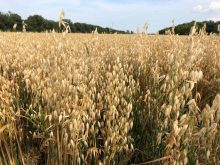Bio-products for crop production are a growing market and companies are developing new and novel ones to meet demand
Formulation isn’t a sexy word in the world of agriculture.
For the last few years, much of the attention and passion in the industry has been directed at words like “automation,” “digital farming” and “climate smart” agriculture.
But formulation is still a critical piece of ag innovation. Someone has to take a concept, like a smart fertilizer, and formulate it into a product that farmers can use. And, preferably, formulate it into something that actually works.
“When you look at a crop protection product or a fertilizer, there’s a lot of formulation (technology) that goes into it … to optimize the product around its release, its dose and efficacy,” said James Maude, a vice-president of Acadian Plant Health, a division of Acadian Seaplants. It is a Nova Scotia company that harvests seaweed and manufactures products for human wellness, animal wellness and plant health.
In the agriculture space, Acadian Plant Health has developed seaweed extracts that potentially boost soil health and provide other benefits to crops. More broadly, it makes and sells bio-stimulants, defined as “substances and microorganisms whose function … is to stimulate natural processes to benefit nutrient uptake, nutrient use efficiency, tolerance to abiotic stress, and/or crop quality,” says the European Biostimulants Industry Council.
Common bio-stimulants include:
- humic acids
- seaweed extracts
- beneficial bacteria and fungi
Acadian Plant Health is one of hundreds of companies hoping to tap into a booming market for crop bio-stimulants. Fortune Business Insights has predicted the global market for bio-stimulants will hit US$5.3 billion in 2027, up from $2.5 billion in 2019.
Demand is growing because farmers are looking to cut fertilizer costs or comply with new regulations around the use of phosphorus and nitrogen.
In Canada, the federal government has proposed to cut greenhouse gas emissions from fertilizer use to 30 percent below 2020 levels. If that happens, farmers may be forced to reduce their use of anhydrous ammonia and urea.
“The regulatory environment is demanding new solutions for (ag) production,” said Jon Treloar, an agronomist with Novozymes, which makes and markets JumpStart, a popular bio-stimulant used on farms across Canada.
“We’re pretty far away from that (in Canada), but we’re probably not as far away as we think.”
One of the main challenges in the bio-stimulant sector is a lack of independent data to verify product performance.
“It really is a buyer beware environment right now. We don’t have a strong extension from any level of government right now, or to some degree, universities as well…. The universities have pulled back on extension,” Treloar said.
In an interview from his office in London, England, Maude said many products in the bio-stimulant industry have not been “optimized” to perform a certain function in the soil.
“Bio-stimulants have been a technology that has been under-invested and overlooked. … As it has been under-invested, then the technology is not optimized,” he said. “Companies would just create a very crude product and go to market with it.”
After that, a company often would claim its product provided 18 different benefits for growers; everything from boosting germination to increasing nutrients in the seed.
“That panacea of outcomes from one dose-rate application … that’s where you get the bad perception of snake oil,” Maude said.
Acadian Plant Health is moving away from the catch-all bio-stimulants approach by making products that provide a specific function for plants — maybe a seaweed extract that improves plant uptake and absorption of calcium, magnesium and zinc.
“There (are) multiple different bio-actives in this seaweed that have different functionalities in the plant,” Maude said. “But in its raw state, it’s not optimized to be specific or selective about any of those (benefits).”
As part of its plan, last year Acadian Plant Health opened a centre of excellence in Malvern, U.K.
Researchers at the centre will design bio-stimulants for “singular functionalities,” Maude said.
One opportunity could be products that help plants withstand and recover from abiotic stress such as drought, temperatures of 35 C and other extreme conditions hostile to plant growth.

The company already has such products on the market, but they’re mostly used on high value crops like avocados and vegetables.
Aside from product formulation, Acadian Plant Health has also invested in a distribution model. The Nova Scotia firm is working with partners in the crop protection and fertilizer industry to provide new products to North American growers.
“We are leveraging the commercial footprint of much bigger organizations than ours by solving some of their key problems and key challenges,” Maude said.
One of those challenges is producing crops in a way that meets public and government expectations around sustainability. In many perceptions, being sustainable means less fertilizer and fewer pesticides.
Seaweed extracts could be used in combination with synthetic fertilizer to cut rates and potentially achieve similar yields.
“That’s what is shifting the market. … The (mainstream) technologies are not as appropriate as they used to be,” Maude said. “There’s a timing with everything … and the stars have (now) aligned for bio-stimulants because they’re a renewable resource and they help in these key areas.”
















